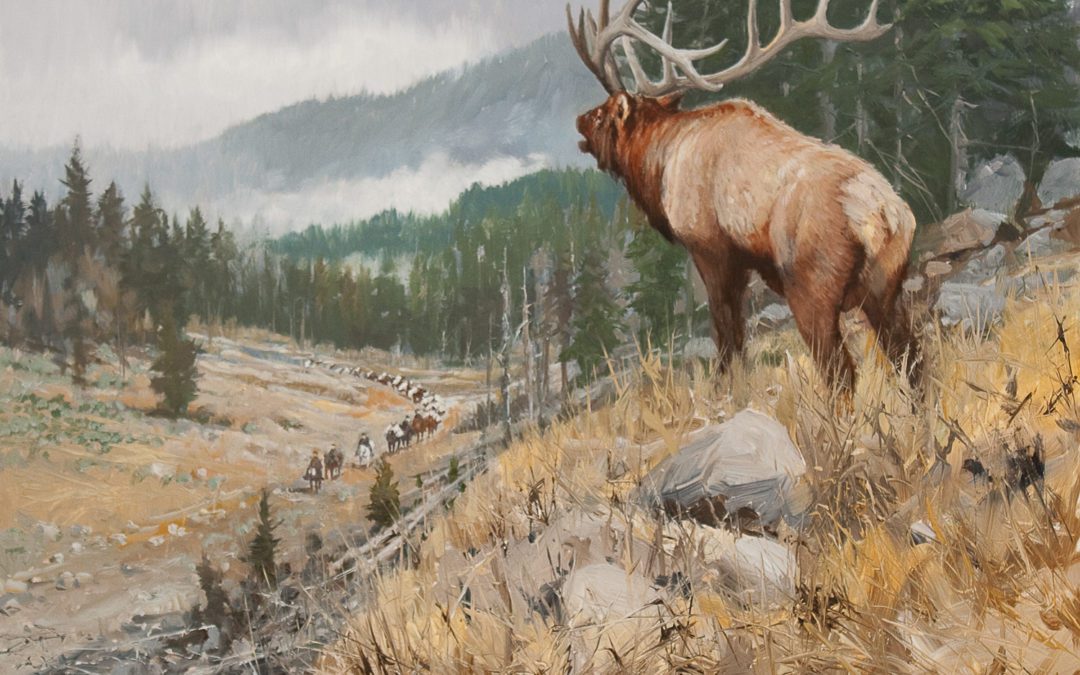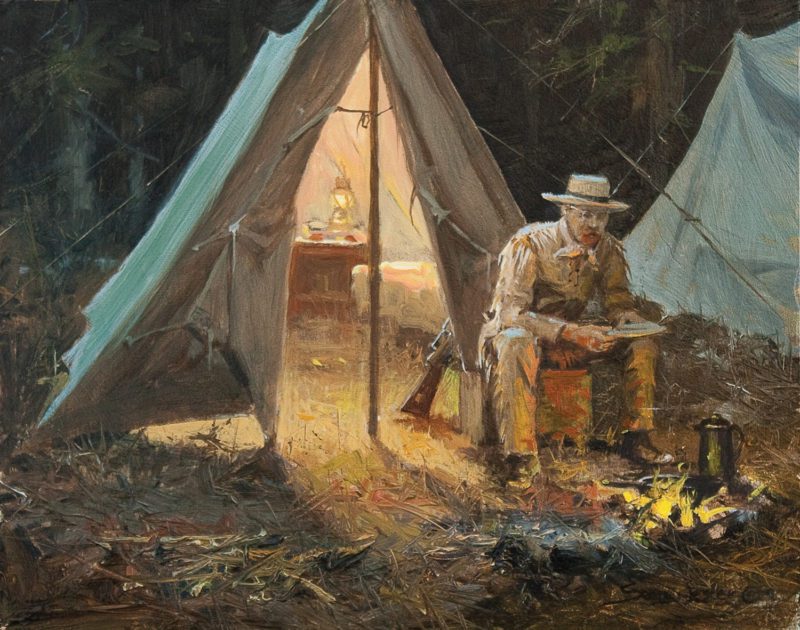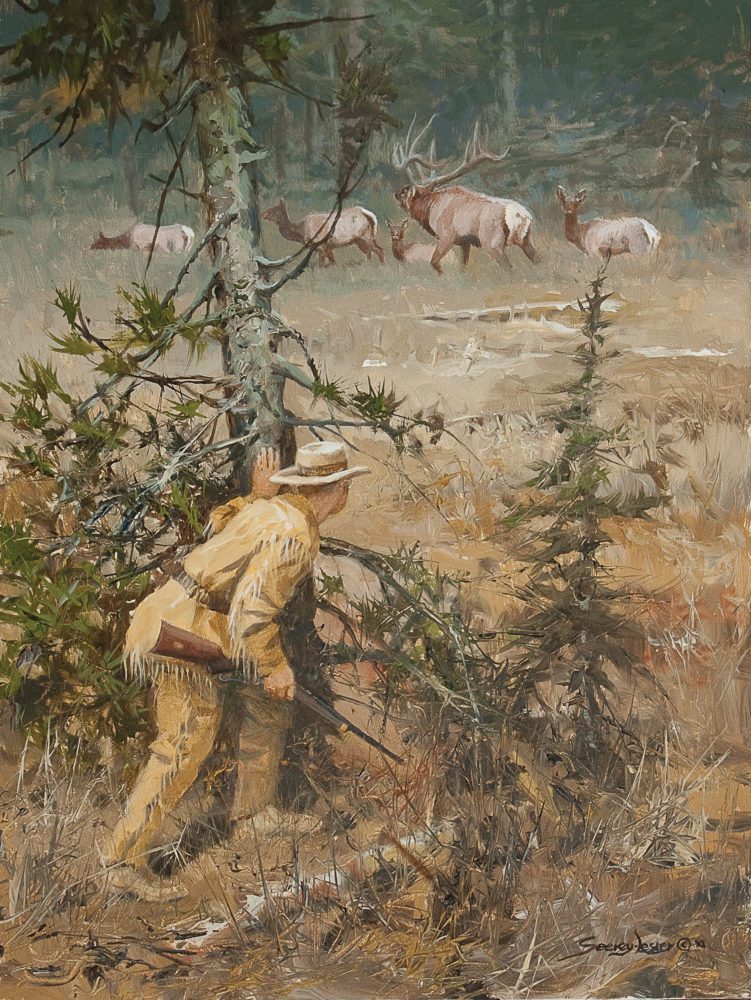TR was especially pleased with the bull, but what he couldn’t know was that he would bag eight more elk, including an even bigger trophy.
Clad in buckskin hunting shirt, moccasins and leggings, the hunter crept silently toward the bull elk and his harem as they grazed across a hillside meadow. As he cautiously peered around a tree, he could feel the chill breeze on his face. Just as the bull threw his head back to rub his shoulders, the hunter raised his rifle and took aim.
It was September, 1891, in Wyoming, and the youthful hunter was Theodore Roosevelt. TR, along with his ranch partner Bob Ferguson, longtime friend Tazewell Woody and Edward Hofer, who doubled as cook and packer, were making for Two-Ocean Pass to hunt elk. The party had 20 horses, 6 to ride and 14 for packs. This was a large outfit for such a hunt, even for TR. Although many of the ponies had seen better days, they were hardy animals, and despite the usual problems of occasional straying, the horses served them well on the long hunting trip. They carried three tepee-style tents, two for sleeping and the other for storing the hunters’ gear and to serve as a dining tent during adverse weather.
The party started out at Heart Lake in northwest Wyoming, an area now within the boundaries of Yellowstone National Park. From there they headed southeast to Two-Ocean Pass where they stayed for about a week. Day after day they rode through the rugged landscape, struggling up and down the slippery hillsides. Occasionally they would dismount and go on foot, leading the packhorses over the more difficult terrain. They traveled in single file, with the tall, silent Woody leading the way.
Although TR would remember the expedition as one of his favorite hunts, the party endured some horrible weather. Most days there was driving rain, which at different altitudes, turned to sleet.
Every now and then the pack train would halt to listen to the distant bugling of elk, then venture into the dense forests on foot. At one point Woody led TR and his fellow hunters toward the incessant calling of a huge bull on the opposite side of a valley. As the group neared their quarry, they heard the shrill bugling of another bull, so close that its strident calls sent shivers down their spines.
The second bull was only 50 yards away when it broke cover and trotted toward the men, swaying its handsome six-by-six rack from side to side. TR fired, hitting him squarely in the chest. After taking the shot, he quickly ran forward and as the elk turned, he fired again, but the shot was not needed. His first bullet mortally wounded the animal and it fell after moving only a few yards.
Several days later, on a cold, clear morning, TR and Woody decided to head out on their own. The two friends rode over the tableland and followed elk trails up and down the mountainsides. The trails were steep and often the men had to climb like mountain goats. Many of the paths led out to open meadows or cliff edges that commanded spectacular views. At the edge of one plateau, they stopped to look across a valley where they saw a large group of cows and calves. Almost instantly they heard the ringing bugle of the herd bull. Following the sound, they rode until they were within 200 yards. TR suddenly pulled up when he saw a huge bull walk into a clearing. Luckily, the animal had not seen the two men. The bull’s pungent odor drifted down toward the hunters, who stood motionless until he strolled out of sight.
They tethered their horses and started to stalk the animal on foot. Within minutes they inadvertently spooked a spike bull, which they feared would alert their target, but instead it just trotted off quietly.
The men moved as fast as they could in the direction of the bull. As they rounded a clump of pines, they came within sight of two cows. The men crouched low to avoid further alerting the females, who were staring directly where Woody was hiding.
While Woody held their attention, TR chose that moment to dash off unobserved, and with the advantage of his buck-skin outfit, was able to sneak undetected up a hillock to within 30 yards of the elk. From his position behind some trees, he could see the bull along with several cows. With his heavy crown of antlers thrown back, the mighty elk strode with a royal demeanor among his subjects.
TR was downwind, but one of the cows caught his movement as he readied for the shot. But it was too late. TR raised his rifle and fired.
Although he had inflicted a mortal wound, TR chased after the great elk, firing two more shots into his flanks, then sending a fourth and final bullet into his neck. TR looked down at his Two-Oceans trophy as it lay on the mountain meadow; its big body sported long, massive antlers.
After several more days of hunting, the party reached Shoshone Territory, where pressing business forced TR to cut short his hunt. From there, Roosevelt and Hofer, along with two pack ponies, traveled fast to the Upper Geyser Basin and then through deep snow to Mammoth Springs, from where he made his return home. Hofer returned with the two horses to Ferguson’s camp, bringing an end to the grand expedition.
In my research for this painting, Suzie and I followed in TR’s footsteps from Heart Lake in Yellowstone National Park through Two-Oceans Pass into Shoshone National Forest and the badlands. It’s important when depicting a historic event to get as close as possible to what actually took place. That’s why we made our journey at the same time of the year as TR’s expedition, although more than a century apart. I painted the exact number of horses and pack mules used by TR and his party on the hunt.



